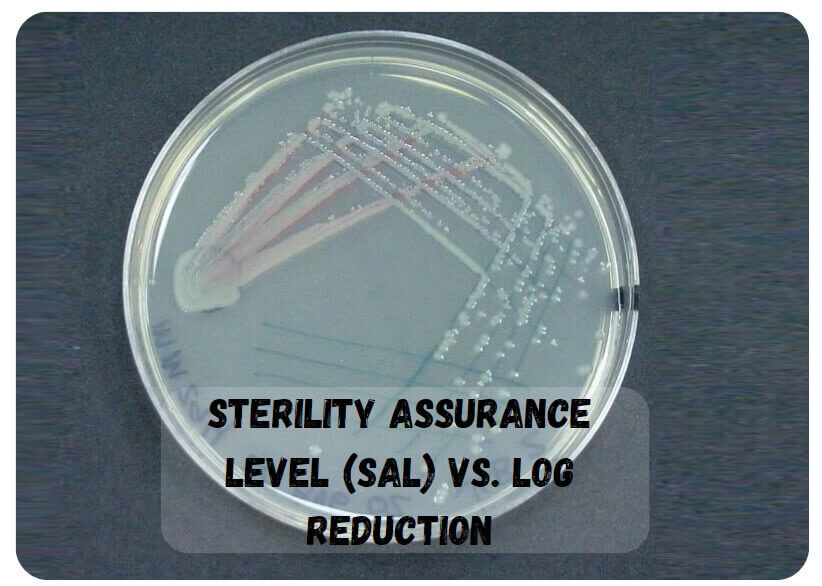Sterilization processes are critical in the pharmaceutical industry for ensuring the safety and efficacy of medical products. To calculate these Pharmaceutical professionals use two terms, Sterility Assurance Level (SAL) and Log Reduction. Understanding these concepts is key to microbial control, quality assurance, and regulatory compliance. In this post, we explore these terms, their calculations, and their practical implications in the pharmaceutical world.

What is the Sterility Assurance Level (SAL)?
Sterility Assurance Level, or SAL, is a probabilistic measure that indicates the likelihood of a single viable microorganism surviving the sterilization process. It’s a standard that serves as a gauge for sterility, with a lower SAL value representing higher sterility assurance.
SAL is defined as “the probability of a single viable microorganism found in or on a product item in a lot after sterilization. If a sterilization method has a Sterility assurance level (SAL) of 10-1, it means there is a 1 in 10 chance that microorganisms can survive during the sterilization process. SAL of 10–2 specifies a 1 in 100 possibility of microorganisms surviving to the end of the sterilization process.
SAL is used in the sterilization industry because the ultimate goal is to have the lowest probability. Generally, the Sterile assurance level (SAL) 10–6 is applied to achieve the sterility level.
- It is important to know that SAL is not the same measurement as log reduction.
- SAL measures the chances of microorganisms surviving the sterilization process.
What is Log Reduction?
Log reduction measurements show the amount or percentage of live microbes eliminated after sterilization.
Log Reduction provides a more substantial measure of microbiological control, indicating the reduction of microbial population after sterilization. One log reduction equates to a tenfold decrease in microorganisms.
To illustrate, a surface with 1000 Colony Forming Units (CFU) of bacteria that undergoes 1 log reduction will have its microbial load reduced to 100 CFUs – representing a significant 90% decrease.
Remember: log reduction only indicates the percentage of microbial removal.
Below is the table for the Percentage of microbial reduction with SAL value:
| 1 log-90% means | SAL -10–1 |
| 2 log-99% means | SAL -10–2 |
| 3 log- 99.9% means | SAL -10–3 |
| 4 logs- 99.99% means | SAL -10–4 |
Generally, SAL 10–6 is required to achieve the sterilization value, and this is assured by a 6-log reduction.
The Calculation of D-Value
D-value is the microbial death rate, representing the time needed to reduce a microorganism population by 90% at a specific temperature. Let’s take a hypothetical organism with a D-value expressed as D121°C=1.5 minutes. This suggests that it requires 1.5 minutes at 121°C to achieve a 1 log reduction.
Calculating the Time Required for Log Reduction
To achieve sterilization value up to 6 log reduction.
1 log consumption time is 2.5×1.0= 2.5 minutes at 121°C, so for 6 log reduction 2.5×6.0 = 15 minutes. In pharmaceutical sterilization with 6 log SAL where 12 log reduction is required, sterilization time should be 2.5×12 = 30 minutes.
In Pharmaceutical companies, 10–6 or 6 logs are required, whereas 12 logs are also required with 2.5×12=30 minutes sterilization time.
Related: Aseptic and Sterile in Pharmaceutical
Real-world Example: Applying Different SAL Values
A 10–6 SAL or a SAL providing greater assurance of sterility (i.e., 10–6, 10-7, etc.) is used for:
- Products intended to come into contact with breached skin or compromised tissue
- Invasive products that enter normally sterile tissue
- Products with claims of sterile fluid pathways
- Surgically implanted devices
A 10–3 SAL or a SAL providing greater assurance of sterility (i.e., 10–4, 10–5, etc.) is used for:
- Products not intended to come into contact with breached skin or compromised tissue.
- Topical products that come in contact with intact skin or mucous membranes.
When a product requires a 10–6, but it is incapable of withstanding the sterilization process, the selection of a SAL other than 10–6 may be necessary.
A different SAL can be applied when all of the following apply:
- The product cannot be designed to allow a sterilization process that achieves a sterile assurance level (SAL) of 10–6 without adversely affecting its function and safety.
- The product offers unique or superior benefits for patient diagnosis, treatment, or care.
- No alternative product is available that can be sterilized with a process that achieves a 10–6 SAL.
Conclusion
Learning the complexities of SAL and Log Reduction is essential for pharmaceutical professionals. They provide a quantitative method to handle the complex challenge of ensuring product sterility.
Are you a pharmaceutical professional seeking more insights into quality assurance and sterilization? Keep exploring for more expert content, and feel free to leave your comments and questions below.
Keywords: SAL, Sterility Assurance Level, Log Reduction, Pharmaceutical Sterilization
References:
- ANSI/AAMI ST67:2003. Sterilization of health care products – Requirements for products labeled “STERIE”
- Wikipedia

Panks Pamyal is a Author and Editor at Pharmaguddu.com. He Worked in Top Pharmaceuticals MNCs in India had a more then 10 years experience in Quality control department. He Delivering most valuable insights and knowledge through this website.
